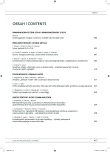The Occurence of Psychogenic Disorders in Neurology
Authors:
K. Obereignerů 1; J. Mareš 1; R. Obereignerů 1,2; P. Kaňovský 1
Authors‘ workplace:
Neurologická klinika LF UP a FN Olomouc
1; Katedra psychológie FF UP v Olomouci
2
Published in:
Cesk Slov Neurol N 2010; 73/106(5): 529-533
Category:
Original Paper
Overview
A third of neurological patients complain of various symptoms resembling some kind of neurological disorder for which obvious explanations are lacking. The aim of this study was to investigate the proportion of inpatients suffering from an actual functional disorder admitted to the neurological clinic of the University Hospital, Olomouc, over a 4-month period from August to November 2007. Methods: The total number of inpatients was 560, 28 of whom (23 females, 5 males), with an average age of 42 years (SD 12.3), range 22–61 years, appeared to be presenting with pain attributable to psychogenic origins. All these patients underwent psychological and psychiatric evaluation. A neuropsychologist administered the Minnesota multiphasic personality inventory (MMPI-2). Results: Dissociative motor and sensory symptoms were confirmed in 50% of cases. A quarter of patients suffered from affective disorder, 11% from anxious-depressive syndrome, while hypochondriac and somatoform disorders were of equal prevalence (7%). There was no pathological finding in MMPI-2 for one quadriplegic patient. Conclusions: The proportion of inpatients with pseudoneurological symptoms over a 4-month period was 4.82%.
Key words:
psychogenic disorder – dissociative disorder – depression – anxiety
Sources
1. Stone J, Zeman A, Simonotto E, Meyer M, Azuma R, Flett S et al. FMRI in patients with motor conversion symptoms and controls with simulated weakness. Psychos Med 2007; 69(9): 961–969.
2. Grawe K. Neuropsychoterapie. Praha: Portál 2007.
3. Sierra M, Berrios GE. Depersonalization: neurobiological perspectives. Biol Psychiatry 1998; 44(9): 898–908.
4. Raszka M, Praško J. Depersonalizace a derealizace – současné nálezy. Cesk Slov Neurol N 2008; 71/104(3): 263–270.
5. Phillips L, Sierra M. Depersonalization disorder: a functional neuroanatomical perspective. Stress 2003; 6(3): 157–165.
6. Yamamotová A, Papežová H. Neurobiologické mechanizmy disociace, bolesti a vnímání vlastního těla. Psychiatrie pro praxi 2002; 5: 213–218.
7. Young JE, Klosko JS, Weishaar ME. Schema therapy: A Practitioner’s Guide. New York: The Guilford Press 2003.
8. Kennedy F, Clarke S, Stopa L, Bell L, Rouse H, Ainsworth C et al. Towards a cognitive model and measure of dissociation. J Behav Ther Exp Psychiatry 2004; 35(1): 25–48.
9. Holmes E, Brown R, Mansell W. Are there two quantitatively distinct forms of dissociation? A review and some clinical implications. Clin Psychol Rev 2005; 25(1): 1–23.
10. Praško J, Pastucha P, Raszka M, Látalová K, Herman E, Hovorka J et al. Disociativní křeče. Cesk Slov Neurol N 2009; 72/105(5): 429–436.
11. Binzer M, Andersen MP, Kullgren G. Clinical characteristics of patients with motor disability due to conversion disorder, a prospective control group study. J Neurol Neurosurg Psychiatry 1997; 63(1): 83–88.
12. First MB, Tasman A. Clinical guide to the diagnosis and treatment of mental disorders. Chichester: John Wiley and Sons 2006.
13. Reuber M, Howlett S, Khan A, Grünewald AR. Non-epileptic seizures and other functional neurological symptoms: predisposing, precipitating and perpetuating factors. Psychosomatics 2007; 48(3): 230–238.
14. Lieb R, Pfister H, Mastaler M, Wittchen HU. Somatoform syndromes and disorders in a representative population sample of adolescents and young adults: prevalence, comorbidity and impairments. Acta Psychiatr Scand 2000; 101(3): 194–208.
15. Slater E, Glithero E. A follow-up of patients diagnosed as suffering from “hysteria”. J Psychosom Res 1965; 9(1): 9–13.
16. Binzer M, Kullgren G. Motor conversion disorder. A prospective 2- to 5-year follow-up study. Psychosomatics 1998; 39(6): 519–527.
Labels
Paediatric neurology Neurosurgery NeurologyArticle was published in
Czech and Slovak Neurology and Neurosurgery

2010 Issue 5
Most read in this issue
- Pudendal Neuralgia – a Case Report
- Development of the PLIF and TLIF Techniques
- Cubital Tunnel Syndrome – a Review of Surgical Treatments and Comparison of their Outcomes
- Gunshot Wounds of the Head and Brain
